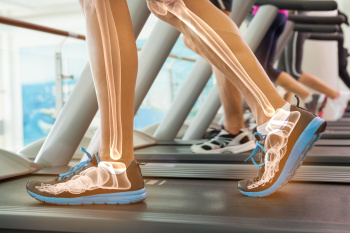Connect With Us
Blog
Items filtered by date: March 2024
The Functionality of Foot Arches

The biomechanics of the human foot comprises three primary arches, which are the medial longitudinal arch, the lateral longitudinal arch, and the transverse arch. These arches, constructed of bones, ligaments, and tendons, play a vital role in providing support, stability, and shock absorption during weight-bearing activities. The medial longitudinal arch, running along the inner edge of the foot, acts as a natural spring, absorbing the impact of each step and distributing the body's weight evenly. Its counterpart, the lateral longitudinal arch, assists in maintaining balance and stability by bearing weight on the outer edge of the foot. The transverse arch, situated across the midfoot, adds further structural integrity to the foot and facilitates weight transfer during movement. Together, these arches work harmoniously to adapt to various surfaces, absorb shocks, and propel the body forward efficiently. If you are interested in learning more about how the arches of the foot work in harmony with the bones, ligaments, and muscles, it is suggested that you confer with a podiatrist who can provide you with interesting information.
If you have any concerns about your feet, contact Robert Hutchison, DPM, FACFAS from Lower Keys Foot & Ankle Surgery. Our doctor can provide the care you need to keep you pain-free and on your feet.
Biomechanics in Podiatry
Podiatric biomechanics is a particular sector of specialty podiatry with licensed practitioners who are trained to diagnose and treat conditions affecting the foot, ankle and lower leg. Biomechanics deals with the forces that act against the body, causing an interference with the biological structures. It focuses on the movement of the ankle, the foot and the forces that interact with them.
A History of Biomechanics
- Biomechanics dates back to the BC era in Egypt where evidence of professional foot care has been recorded.
- In 1974, biomechanics gained a higher profile from the studies of Merton Root, who claimed that by changing or controlling the forces between the ankle and the foot, corrections or conditions could be implemented to gain strength and coordination in the area.
Modern technological improvements are based on past theories and therapeutic processes that provide a better understanding of podiatric concepts for biomechanics. Computers can provide accurate information about the forces and patterns of the feet and lower legs.
Understanding biomechanics of the feet can help improve and eliminate pain, stopping further stress to the foot.
If you have any questions please feel free to contact our office located in Key West, FL . We offer the newest diagnostic and treatment technologies for all your foot and ankle needs.
Stop Your Toenail Fungus
Causes of Corns on the Feet

Corns, also known as helomas, are a common foot condition characterized by thickened, hardened areas of skin that develop in response to friction or pressure. These small, round, or conical lesions typically form on the toes, sides of the feet, or on weight-bearing areas. Corns result from repetitive rubbing or friction against footwear or adjacent toes, leading to the accumulation of dead skin cells. Wearing ill-fitting shoes, high heels, or tight socks, or having foot deformities such as hammertoes or bunions can increase the risk of corn formation. Additionally, activities that involve prolonged standing or walking contribute to increased pressure on the feet, further predisposing individuals to corns. Poor foot hygiene and inadequate moisture control may also contribute to corn development. While corns are generally harmless, they can cause discomfort, pain, and difficulty wearing shoes. If you have developed a corn on your foot, it is suggested that you visit a podiatrist who can offer you effective treatment methods.
If you have any concerns regarding your feet and ankles, contact Robert Hutchison, DPM, FACFAS of Lower Keys Foot & Ankle Surgery. Our doctor will treat your foot and ankle needs.
Corns: What Are They? and How Do You Get Rid of Them?
Corns can be described as areas of the skin that have thickened to the point of becoming painful or irritating. They are often layers and layers of the skin that have become dry and rough, and are normally smaller than calluses.
Ways to Prevent Corns
There are many ways to get rid of painful corns such as wearing:
- Well-fitting socks
- Comfortable shoes that are not tight around your foot
- Shoes that offer support
Treating Corns
Treatment of corns involves removing the dead skin that has built up in the specific area of the foot. Consult with Our doctor to determine the best treatment option for your case of corns.
If you have any questions please feel free to contact our office located in Key West, FL . We offer the newest diagnostic and treatment technologies for all your foot and ankle needs.

